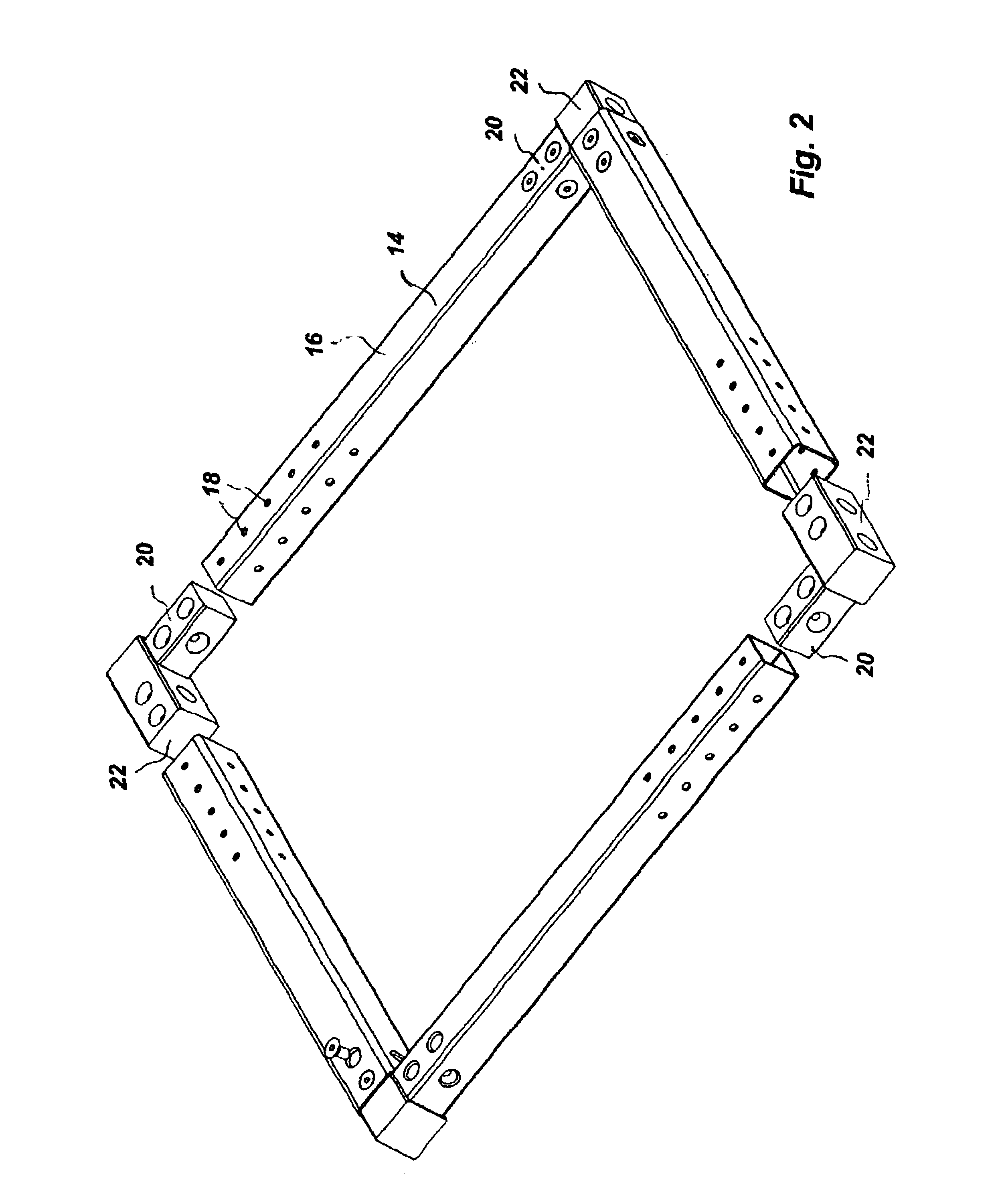Frame connection mechanism
a frame connection and mechanism technology, applied in the direction of rod connection, manufacturing tools, building scaffolds, etc., can solve the problems of rust and erioration of welded joints, difficulty in undoing of welded joints, and many structural problems, so as to reduce shipping costs, avoid damage to the structure in transit, and the effect of the same strength
- Summary
- Abstract
- Description
- Claims
- Application Information
AI Technical Summary
Benefits of technology
Problems solved by technology
Method used
Image
Examples
second embodiment
[0058]FIG. 8 illustrates an alternative first insert construction wherein the insert does not include an extension member 30. Instead, the endwall 37 defines the entry of a channel 52A which extends into the body of the insert 20. In this embodiment, the counterpart channel 58B extends completely through the body of the second insert 22. Furthermore, that portion of the channel 58 which extends beyond the countersink 58C is of a constant diameter over the length of the channel. The structure and operation of the second embodiment are essentially identical to the previously described embodiment except for the above described differences.
third embodiment
[0059]the invention is illustrated in FIGS. 9-12. This embodiment is adapted to form a “T” shaped union of three tubular elements, 16C, 16D, and 16E as illustrated in FIG. 12. Such a “T” union is oftentimes utilized to form a reinforcement structure for a conventional rectangular frame construction.
[0060]This embodiment includes a first insert 120 which is configured essentially identical to the first insert 20 described above. The second insert 122 is modified from the second insert 22 described above. As shown in FIG. 9 the second insert 122 is an elongate member having a quadrilaterally configured cross section and four planar sides. As shown in FIG. 9 the side 150 defines at least two channels 144A and 144B. Similar to the channels previously described, these two channels have a countersunk region which intersects the planar surface of the side of the insert. The channel extends symmetrically from the countersunk region into the body of the insert along a linear longitudinal axi...
first embodiment
[0062]As previously described with respect to the first embodiment, a connection member 164 is inserted into each of the apertures 118 which is aligned with a respective channel 140B or 140A. The connection member 164, which may be either a self tapping screw or alternatively a threaded bolt which is dimensioned to intercorporate with female threads formed on the interior sidewall of the respective channels 140A and 140B. Furthermore, the two tubular members 16C and 16D may be aligned to bring each of the channels 158A, 158B, 144A and 144B into registration with a respective aperture 118. A connection member 165 may then be inserted into each of the apertures 118 so aligned and thereafter into the counterpart channel 158A, 158B, 144A or 144B to form a threaded union of the tubular member with the second insert. Similarly, the third tubular member 16E may be slid into place about the first insert 120 to bring the channels 132 and 136 into registration with respective apertures 118. T...
PUM
 Login to View More
Login to View More Abstract
Description
Claims
Application Information
 Login to View More
Login to View More - R&D
- Intellectual Property
- Life Sciences
- Materials
- Tech Scout
- Unparalleled Data Quality
- Higher Quality Content
- 60% Fewer Hallucinations
Browse by: Latest US Patents, China's latest patents, Technical Efficacy Thesaurus, Application Domain, Technology Topic, Popular Technical Reports.
© 2025 PatSnap. All rights reserved.Legal|Privacy policy|Modern Slavery Act Transparency Statement|Sitemap|About US| Contact US: help@patsnap.com



